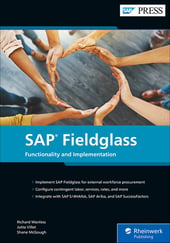In this post, we’ll take a look at how to implement and complete an SAP Fieldglass project.
Let’s start by introducing you to the SAP Fieldglass solution. SAP Fieldglass is SAP’s market-leading vendor management system (VMS) for contingent labor, independent contractors, statement of work workers and outsourced services. Organizations, no matter their size, often struggle to source and engage external workers efficiently while competing for the best talent. The value proposition of SAP Fieldglass is simple: software that focuses on the management of external workers, from determining staffing requirements (as part of recruitment and sourcing), through active management of ongoing engagement and service orders, to billing and invoicing of the time, expenses, and services performed.
SAP Fieldglass can be used as standalone software solution, or as an integral part of sophisticated IT system landscapes through integrations with other applications and systems. When companies choose an integrated solution, this is often due to the scale and scope of external workforce management, as well as considerations about IT security, compliance, and corporate strategy. Most common are integrations with HR or other employee management systems (i.e., to provide total workforce management) or to ERP and procurement solutions for seamless procurement, requisitioning and purchasing, and invoicing. Other supporting integrations relate to master data, time recording, and peripheral systems for onboarding and asset management.
The basic functions of SAP Fieldglass are divided into four procurement processes that can be used independently of each other: For classic, temporary external labor, the Contingent module is used. The Services module supports statement of work contracts and service-related external workforce, which can include an optional bidding process. The Assignment Management module is used to support contingent workers assigned multiple tasks and engagements under umbrella supplier agreements. The Profile Worker module is used to simply track external workers without subsequent invoicing.
How is SAP Fieldglass Implemented?
Based on the software-as-a-service (SaaS) principle, SAP Fieldglass provides a relatively simple method of implementation, a flexible and stable system, and as a result, a fast time-to-value process for companies and corporations.
The most complex procedure is the initial, new implementation of a program that runs through all phases of the implementation. There are two main reasons for a new implementation: either no system is currently in use that manages external workers electronically and holistically, or one or more systems are to be replaced by SAP Fieldglass.
The effort required for a net-new implementation (called “greenfield”) is significantly lower than for a system conversion (called “brownfield”). A greenfield implementation doesn’t take into account current external workers or SOWs that have already been created. Only new requests are entered in the system. With a brownfield implementation, however, existing workers and SOWs are transferred to the new system. This data migration from legacy systems takes additional time, particularly to collect the data. With a geographical expansion of an existing program, the requirements already exist and need to be adapted locally. The design phase is therefore short but might need a particular focus on local legal requirements and often the rate setup. An initial scoping should include an estimation of time needed for the local adoption of a global blueprint.
In contrast, there are functional enhancements gained if, for example, another SAP Fieldglass module is added to a current setup. The system and process design is particularly important here because some settings can only be made across the entire system architecture and modules, and other settings can be made individually and are specific to the module. Examples of functional enhancements include the following:
- Introduction of an additional sourcing process (for any of the modules) if you haven’t used all modules thus far
- Introduction of one or more Managed Service Providers (MSPs)
- Introduction of complex rates, rate schedules, or a rate change matrix
- Integrations to other systems, for example, SAP Ariba, SAP S/4HANA, or SAP SuccessFactors
Introducing additional functions within a module in SAP Fieldglass is more of a project than an implementation. The adaptation of functions to new business requirements and the introduction of new modules is also project-based. These include, for example, changing the company structure or master data, revising the job posting templates, redesigning rate requirements, or revising the approval groups. Nevertheless, careful planning is also necessary here to avoid disrupting day-to-day business. In addition, rollouts to other business units are project-based and may include data migration and business unit-specific approval groups, job posting templates, and user requirements.
A continuous improvement process may require the restructuring or realignment of SAP Fieldglass. To ensure that this works smoothly, the execution should be thoroughly planned and aligned to the regular product updates that SAP Fieldglass releases. If you need assistance reviewing your current system setup or evolving your external workforce program, contact SAP Fieldglass or an SAP partner.
Companies that have chosen to use an MSP or work with an SAP partner will be supported during their implementation. They often perform implementation tasks in process design, supplier management, data collection and migration, and change management. As they often have experience in the local market, critical tasks such as rate designs and compliance matters are part of the advisory services.
An MSP or SAP partner has an intrinsic motivation to implement SAP Fieldglass and its support service within the agreed time frame due to their business model. This has a positive impact on the whole project. The implementation methodology of MSPs and SAP partners is generally aligned with the SAP Fieldglass methodology, and years of experience have been gained in the joint implementation of the system, displaying the true meaning of a partnership and collaboration.
Program Organization
SAP Fieldglass is a software solution for facilitating your external workforce management. The most successful programs are organized around a team that manages the administration and process within the system and organization. This team manages processes around SAP Fieldglass in day-to-day operations, answers user questions, and monitors compliance. A core task of this team is to administer SAP Fieldglass—such as onboarding new suppliers, adapting job posting templates, and making rate changes. The program managers can be a dedicated internal team of experts from the areas of purchasing, HR, IT, payroll, or legal, or can be provided by an external company, such as an MSP or SAP partner.
Companies often use specialized consulting companies or technology experts that not only support the implementation but are also involved in program management. Training, optimizing system processes, supplier management, and data migration are all handed over to consultants, as the effort often goes beyond the capacity of a PMO management team. Ongoing programs benefit from external technology consulting primarily to drive innovation. This service is also offered by certified SAP partners. They help companies implement, technically evolve, and embed SAP Fieldglass solutions into their organization.
The concept of an MSP is the outsourced program management and sourcing of contingent and services procurement. MSPs are offered by all major HR service providers as a standard service for the management and governance of SAP Fieldglass within the organization. Working with an MSP can bring many benefits, including:
- Market experience and supplier relationships
- Proven process efficiency and technology skills
- Global program scalability
- Visibility, cost savings, and compliance
A MSP programs is are financially self-sustaining, and there are no direct costs, as MSPs are usually set up as a supplier-funded model. To cover its own costs, the MSP holds back a percentage of the amount invoiced by a supplier, called the MSP fee. The corresponding calculation is built into SAP Fieldglass as an optional configuration.
In most companies, the MSP functions as an integral part of HR and procurement, and it covers all aspects arising from the use of external workers in temporary work or SOW. It also acts as the central point of contact and forms the interface between the company and supplier
To ensure that your implementation and continuous improvement process works smoothly, the execution should be well planned and aligned to with your needs as well as the regular product updates that SAP Fieldglass releases and your program needs.
If you need assistance reviewing your current system setup or evolving your external workforce program, contact SAP Fieldglass or an SAP partner.
This post was originally published 3/2022.




Comments